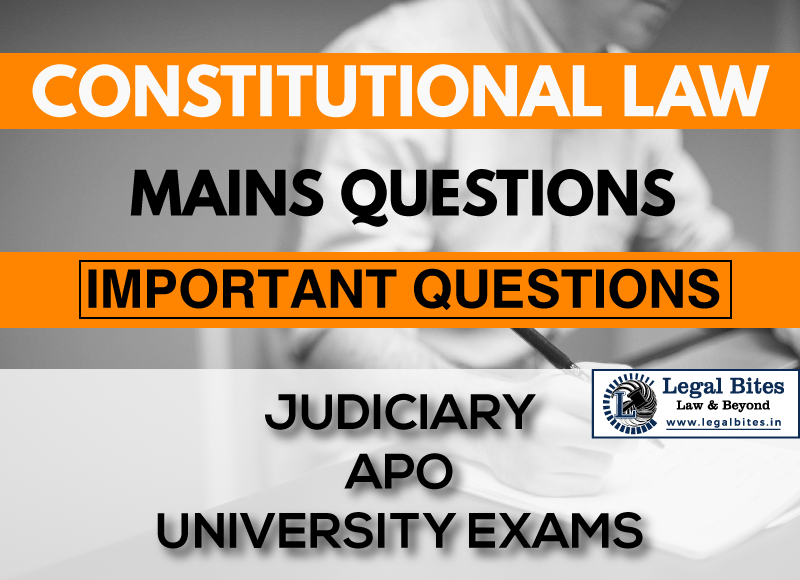What are the application and interpretation of Article 13 of the Constitution? Discuss the doctrines precisely with leading cases.
Find the answer to the mains question of Constitutional Law only on Legal Bites.

Question: What are the application and interpretation of Article 13 of the Constitution? Discuss the doctrines precisely with leading cases. [BJS 2018] Find the answer to the mains question only on Legal Bites. [What are the application and interpretation of Article 13 of the Constitution? Discuss the doctrines precisely with leading cases.] Answer Article 13 of the Indian Constitution plays a pivotal role in ensuring the supremacy of the Constitution and safeguarding fundamental rights....
Question: What are the application and interpretation of Article 13 of the Constitution? Discuss the doctrines precisely with leading cases. [BJS 2018]
Find the answer to the mains question only on Legal Bites. [What are the application and interpretation of Article 13 of the Constitution? Discuss the doctrines precisely with leading cases.]
Answer
Article 13 of the Indian Constitution plays a pivotal role in ensuring the supremacy of the Constitution and safeguarding fundamental rights. It declares that all laws inconsistent with or derogatory to fundamental rights shall be void to the extent of such inconsistency. It is divided into four clauses:
- Article 13(1): Pre-Constitution laws inconsistent with fundamental rights are void.
- Article 13(2): The State shall not make any law contravening fundamental rights.
- Article 13(3): Defines "law" broadly to include ordinances, orders, rules, regulations, notifications, and bye-laws.
- Article 13(4): Introduced by the 24th Amendment, clarifies that constitutional amendments under Article 368 are not "laws" under Article 13.
Doctrine of Eclipse
This doctrine applies to pre-Constitution laws that violate fundamental rights. Such laws are not void ab initio but remain dormant or "eclipsed" to the extent of their inconsistency. They can be revived if the fundamental right ceases to exist or is amended.
Bhikaji Narain Dhakras v. State of Madhya Pradesh (1955): The Supreme Court held that a pre-Constitution law inconsistent with Article 19 became enforceable once the inconsistency was removed by constitutional amendment.
Doctrine of Severability
Under this doctrine, if a part of a law is unconstitutional but the remainder can function independently, the invalid part is severed, and the rest remains in force.
R.M.D. Chamarbaugwalla v. Union of India (1957): The Court upheld the valid parts of a law while striking down the unconstitutional portions, provided they were severable.
Doctrine of Prospective Overruling
This doctrine ensures that when a law is declared unconstitutional, the declaration operates prospectively, not retrospectively, to avoid disruption. It is used in constitutional interpretation.
Golaknath v. State of Punjab (1967): The Supreme Court held that the doctrine applies to cases where laws previously upheld are now found unconstitutional due to evolving jurisprudence.
Basic Structure Doctrine and Article 13
Though Article 13 explicitly excludes constitutional amendments (Article 13(4)), the Kesavananda Bharati v. State of Kerala (1973) case introduced the Basic Structure Doctrine, ensuring that no amendment can alter the Constitution’s basic structure. The Court held that the power to amend the Constitution is subject to implied limitations.
Judicial Review under Article 13
Article 13 empowers the judiciary to strike down laws inconsistent with fundamental rights, reinforcing the principle of judicial review.
Minerva Mills v. Union of India (1980): The Court reaffirmed the role of judicial review as a basic feature of the Constitution, ensuring that Article 13 is not diluted.
Article 13 acts as the guardian of fundamental rights and establishes the framework for constitutional supremacy, judicial review, and the harmonious coexistence of laws. It underscores the dynamic relationship between the judiciary and the legislature in upholding the rule of law.
Important Mains Questions Series for Judiciary, APO & University Exams
- Constitutional Law Mains Questions Series Part-I
- Constitutional Law Mains Questions Series Part-I
- Constitutional Law Mains Questions Series Part-II
- Constitutional Law Mains Questions Series Part-IV
- Constitutional Law Mains Questions Series Part-V
- Constitutional Law Mains Questions Series Part-VI
- Constitutional Law Mains Questions Series Part-VII
- Constitutional Law Mains Questions Series Part-VIII
- Constitutional Law Mains Questions Series Part-IX
- Constitutional Law Mains Questions Series Part-X
Admin Legal Bites
Legal Bites Study Materials correspond to what is taught in law schools and what is tested in competitive exams. It pledges to offer a competitive advantage, prepare for tests, and save a lot of money.
